
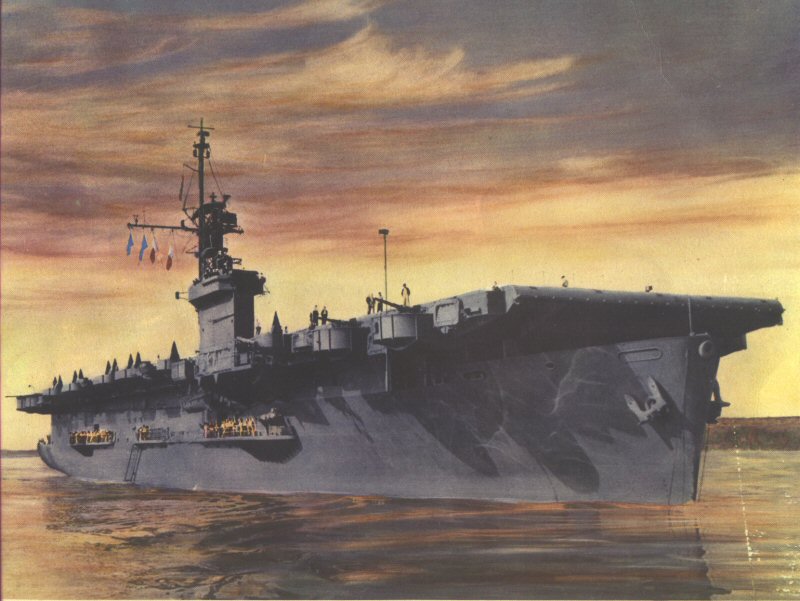 This drawing, labeled "U.S.S. Savo Island (CVE 78)" was given to the men who served on her.
Although labeled as a picture of the Savo Island, it was, in fact, a generic drawing of a Casablanca Class escort carrier.
The same drawing was given to men on other ships and labeled with the name of their ship.
This drawing, labeled "U.S.S. Savo Island (CVE 78)" was given to the men who served on her.
Although labeled as a picture of the Savo Island, it was, in fact, a generic drawing of a Casablanca Class escort carrier.
The same drawing was given to men on other ships and labeled with the name of their ship.
From July 1944 through January 1945, VC-27 was assigned to the escort carrier U.S.S. Savo Island (CVE 78) commanded by Capt Clarence E. "Swede" Ekstrom.
The "Savo Island" was an escort carrier of the Casablanca Class. The first escort carriers were merchant ships converted to escort carriers with the addition of a flight deck. The "Savo Island" was a "second-generation" escort carrier of the Casablanca Class. These were designed from the ground up as escort carriers.
Some crews joked that the initials CVE stood for "Combustible, Vulnerable and Expendable". They were attractive targets for the Japanese kamikazes looking for a carrier to attack and they did not have the speed or defensive armament of a full-sized carrier.
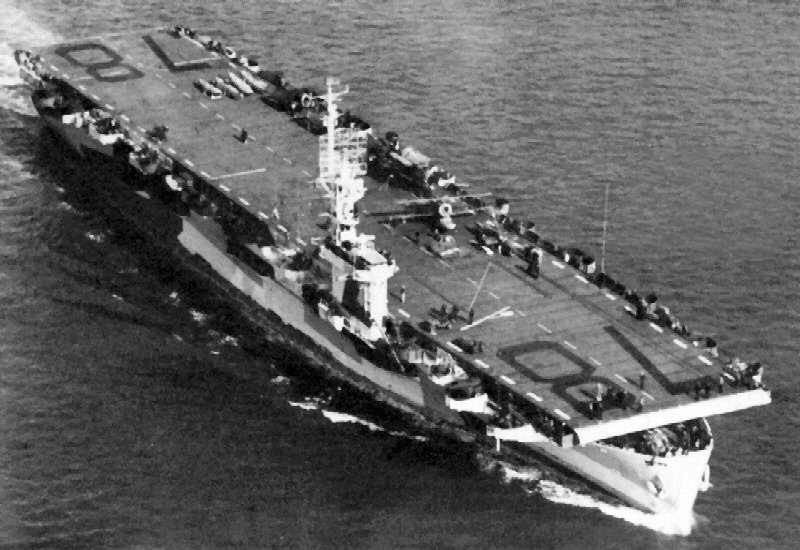 The Savo Island underway. For more information on the Savo Island, go to
Wikipedia.
The Savo Island underway. For more information on the Savo Island, go to
Wikipedia.
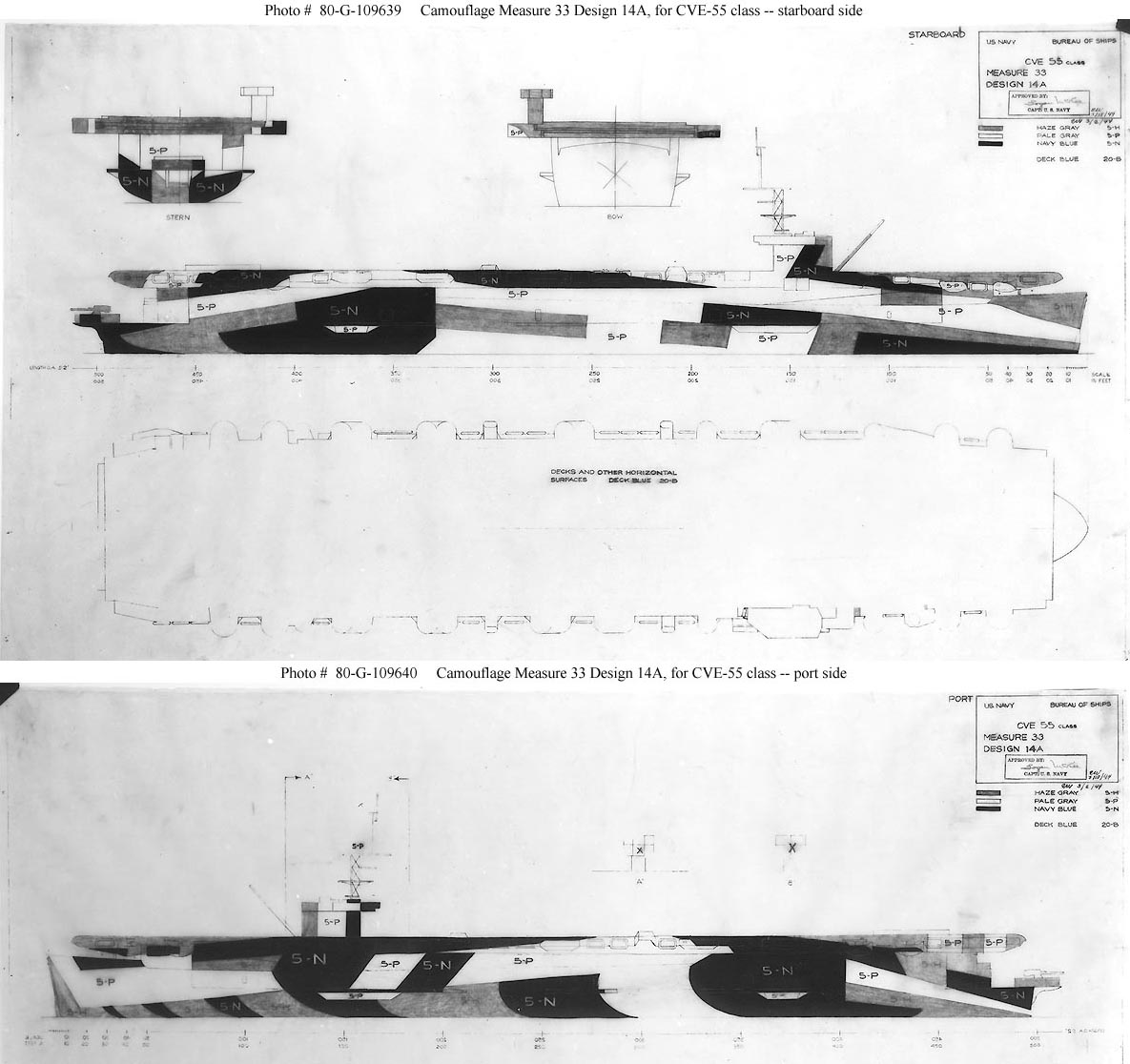 Standard 3 color camouflage markings for CVE - the colors are Navy Blue, Haze Gray and Pale Gray.
Standard 3 color camouflage markings for CVE - the colors are Navy Blue, Haze Gray and Pale Gray.
 |
This picture of the port side of the U.S.S. Savo Island while underway confirms that the ship was painted in the standard markings.
|
|---|
|
Type of Carrier: |
CV-9 Essex Class Aircraft Carrier |
CVL-21 Enterprise Class Light Carrier |
CVE-55 Casablanca Class Escort Carrier |
|---|---|---|---|
| Displacement - full (tons): | 34,880 | 11,000 | 10,902 |
| Speed (knots): | 33 | 31 | 19 |
| Crew | 2,631 | 1,569 | 764 |
| Planes | 88 | 34 | 27 |
| Length (feet) | 872 | 622 | 498 |
| Beam - extreme (feet) | 147 | 109 | 108 |
| Draft - loaded (feet) | 27 | 26 | 21 |
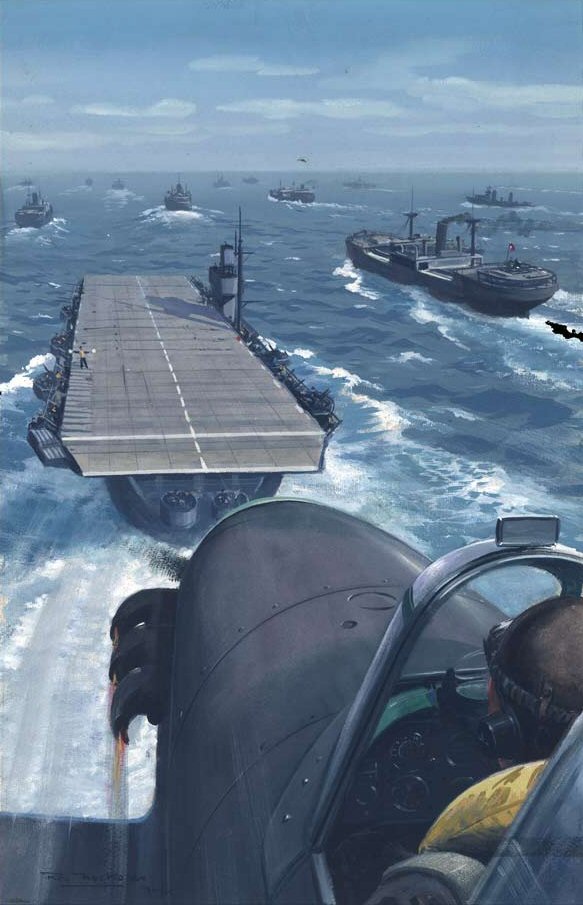
A depiction of the first plane returning to land on an escort carrier.
The flagman is signaling that the landing is "on target".
But, he is ready to jump off to the side if things go bad.
|
During World War II, all carriers had "straight decks". This meant that, during takeoffs, planes waiting for take-off were parked at the back of the ship and planes took off from the front. During recovery, planes that had landed were parked at the front of the ship and planes landed on the back. This meant that only about 2/3 of the deck was available for take-offs and landings. Landing on a carrier, especially an escort carrier, took a great deal of skill. The planes that had already landed were parked in the front protected only by a cable barricade. The pilot had to try to touch down on a precise area on the rear 1/3 of the deck and hope that his tail hook would catch one of the arresting cables stretched across the deck. In order to hit this area, he had to plan his approach, taking into account the wind speed and the speed of the carrier. Because escort carriers did not have the speed of regular carriers, his landing speed was going to be higher. He also had to take into account whether the ship was rocking - more likely with a small escort carrier. He tried to time his landing so that, when he hit, his aircraft or tail hook did not bounce off the deck and cause him to miss the cables. But, just in case, he had to be ready to react in a split-second by fire-walling the throttle and banking to the left to avoid hitting the planes on the deck (a difficult challenge if your airspeed is almost down to zero). In some cases, the pilot had no choice but to chop the throttle and hope that the barricade would stop him. Even the best carrier landing is little more than a "controlled crash". |
|---|
 This model of a Casablanca Class escort carrier shows the camouflage color scheme and about 12 planes on the deck.
A real escort carrier had to find room for more than twice that number of planes, and leave enough space for take-offs and landings.
This model of a Casablanca Class escort carrier shows the camouflage color scheme and about 12 planes on the deck.
A real escort carrier had to find room for more than twice that number of planes, and leave enough space for take-offs and landings.
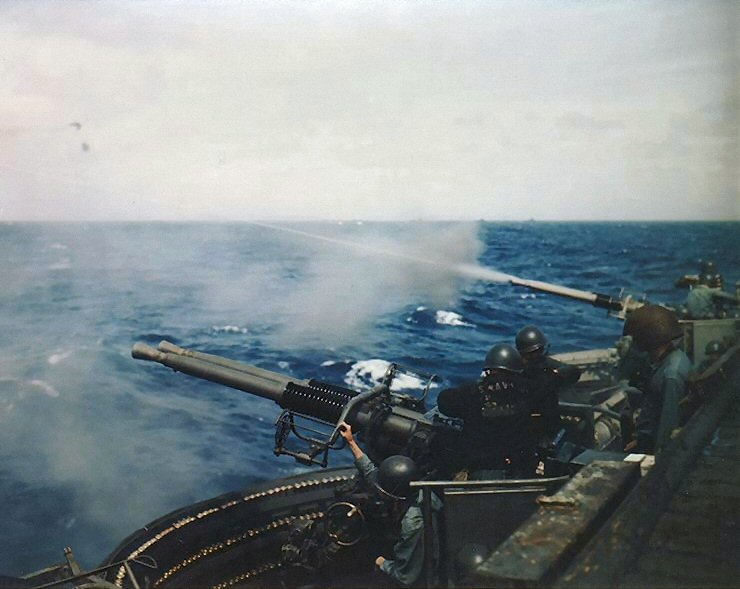 Gunnery practice aboard the CVE Makin in March 1945. These men were the last line of defense against deadly kamikaze attacks.
Gunnery practice aboard the CVE Makin in March 1945. These men were the last line of defense against deadly kamikaze attacks.
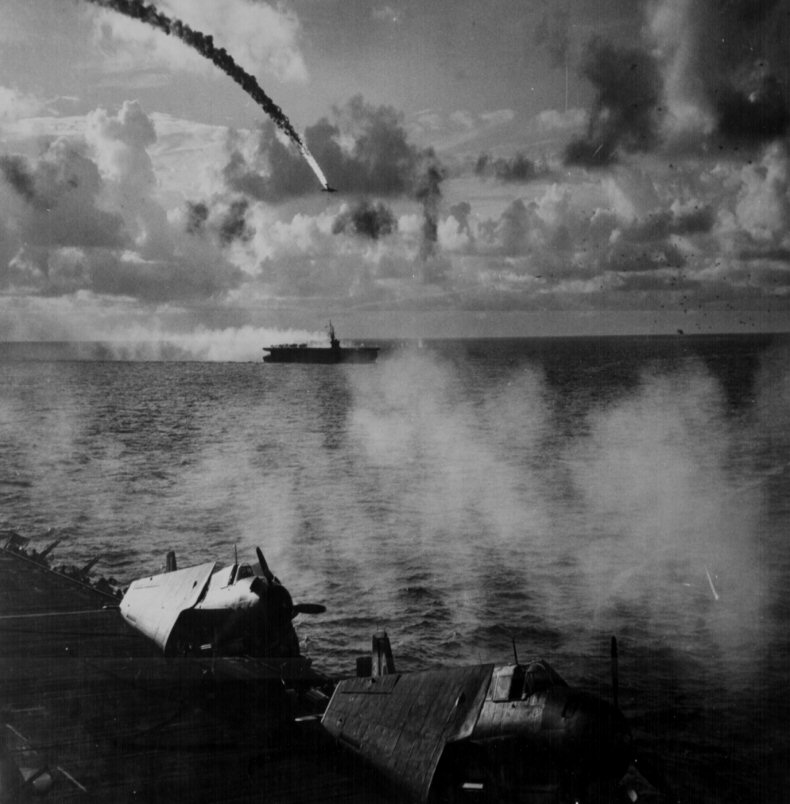 A kamikaze unsuccessfully attacks an Escort Carrier
A kamikaze unsuccessfully attacks an Escort Carrier
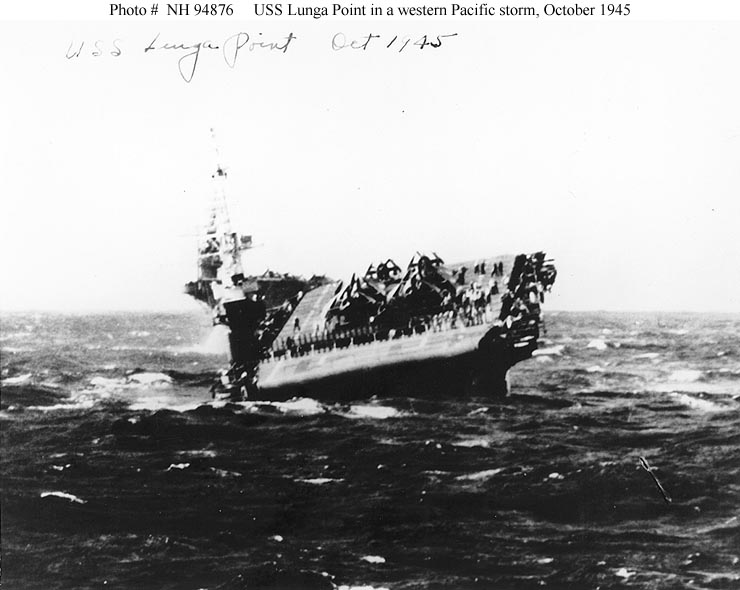 As this picture shows, big storms could be pretty rough on escort carriers.
As this picture shows, big storms could be pretty rough on escort carriers.
In addition to being aviators, the men of VC-27 were also sailors. They participated in the traditional celebrations associated with crossing the equator. They enjoyed the good food (which was the primary reason that Pat Simmons enlisted in the Navy). They suffered along with the ship. With a crew of only 764 men, an escort carrier was a tightly-knit community.
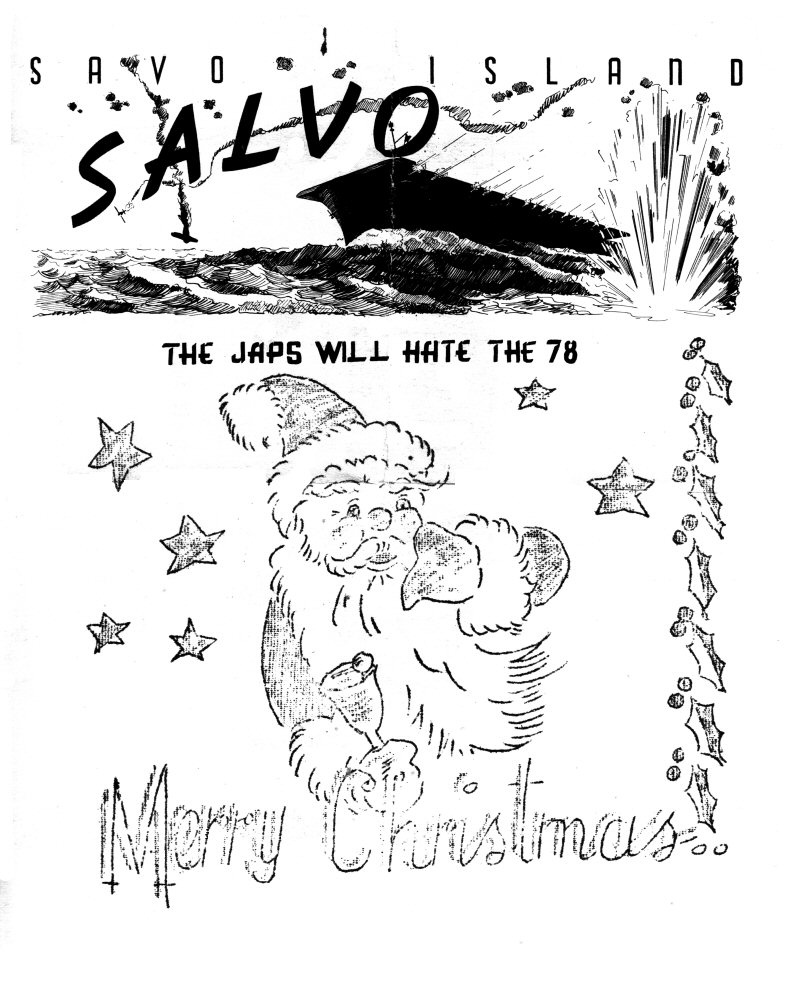 This is the first page of the menu for Christmas Dinner 1944.
This is the first page of the menu for Christmas Dinner 1944.
By Christmas 1944, the men of the Savo Island had been through some rough battles. While the aviators were providing air and ground support for the invasions, the men on the ship were fighting off waves of kamikaze attacks (as shown in the picture at the top of the menu). A single kamikaze could sink a ship the size of an escort carrier.
